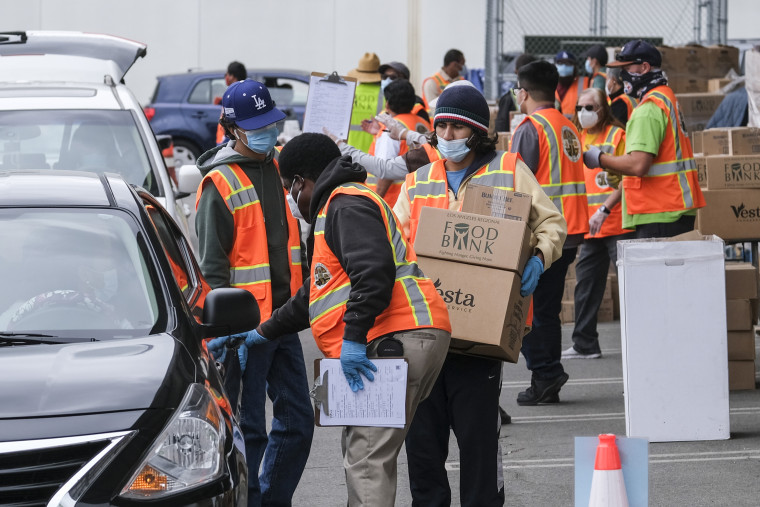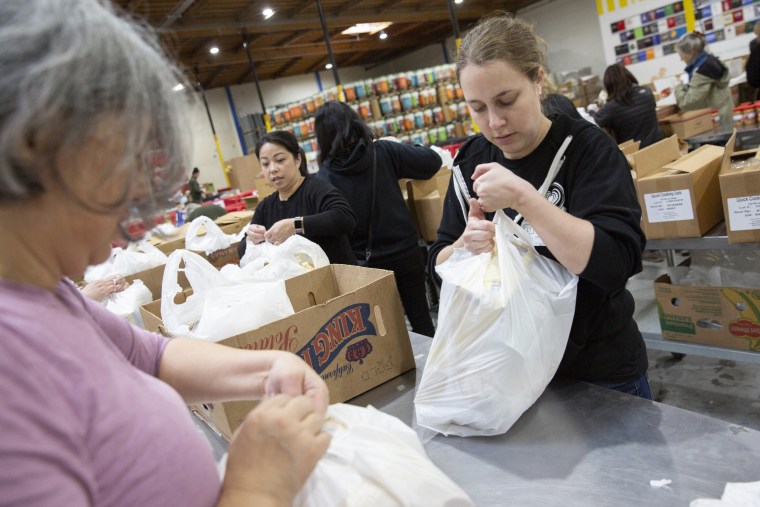ANAHEIM, California — Two food banks in California have been gearing up for a busy holiday season: One is spending tens of thousands amid rising food prices, and the other has been serving triple the number of people since the coronavirus pandemic began.
The Alameda County Community Food Bank in Oakland is dealing with the toll of rising food prices and supply chain issues as it serves families grappling with food insecurity.
“They’re depending on us,” said Elizabeth Gomez, director of client services at the food bank.
Over the past year, food prices have increased 5.3 percent, according to the U.S. Bureau of Labor Statistics.
Because of food price increases, the food bank is spending an additional $60,000 on food per month.
“We need to be ahead of the game as much as we can,” said Gomez, 48, who’s been working with the organization for 24 years.
She said the food bank has seen price increases across the board for seven core items, with oatmeal and frozen chicken seeing the highest increases at 17.1 percent and 13 percent respectively. In total, it is spending more than $1 million on food per month — compared to $250,000 each month before the pandemic.
“Part of the increase is because we’re willing to spend more on food to ensure that we actually secure it,” Gomez said. The backlog of shipments along the California coast has created supply chain issues and has contributed to less inventory and increased transportation costs for the food bank.
The food bank has had to turn to alternatives such as single serve cereal bowls to replace oatmeal, and turned to Costco to get a variety of canned meats for canned tuna that has been running late.
“We are expecting more than 400,000 Alameda County residents,” Gomez said. “We’re bracing for what is to be the busiest month and a half ahead for us.”
In 2020, rough estimates indicate 45 million people, or 1 in 7, experienced food insecurity as the pandemic forced tens of millions to suffer from unemployment or saw their hours decline, according to an analysis by Feeding America, a nationwide nonprofit network aiming to ensure equitable access to food in the United States.
With a recovering economy and increasing vaccination records, the organization projects improved food insecurity conditions in the holiday season but still higher than pre-pandemic numbers.
Feeding America predicts that 42 million people — about 1 in 8 — may experience food insecurity, compared to about 1 in 9 in 2019, the lowest point reached then since food insecurity began being measured in the 1990s, according to the report.
The Los Angeles Regional Food Bank has been serving triple the number of people it usually saw before the pandemic — from 300,000 to 900,000 each month, according to Olivia Cervantes, 33, its marketing content manager.

It’s a number that aligns with a recent University of Southern California study detailing that 1 in 10 Los Angeles County residents experienced food insecurity in the first half of 2021 — and 59 percent of them were Latino.
“It was time to give back to my community as an Angeleno,” Cervantes said, explaining she felt compelled to help after witnessing the pandemic’s impact on the city's Hispanic community. “Even if we were to return back to normal or even if this lingers on, the issue is still there, hunger is a year-round issue.”
California is home to the nation’s largest Latino population. In Los Angeles County, Hispanics or Latinos account for almost half (48.6 percent) of the population.
The Los Angeles food bank has been minimally impacted by the surge in food prices and supply chain issues because the majority of its food is donated and sourced locally.
However, it has had to grapple with other issues: The number of volunteers declined from 30,000 to 15,000 because of Covid-19 safety protocols. The organization has turned to AmeriCorps for help with distribution.
"The food bank really does stretch the dollar to help as many people as possible," Cervantes said.
Organizers say those who want to volunteer or donate can contact the Los Angeles Regional Food Bank's website or call 323-234-3030 or the Alameda County Community Food Bank's website or call 510-635-3663.
Follow NBC Latino on Facebook, Twitter and Instagram.

